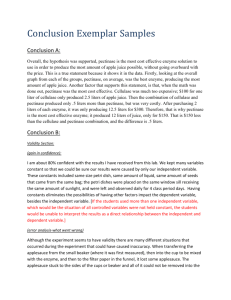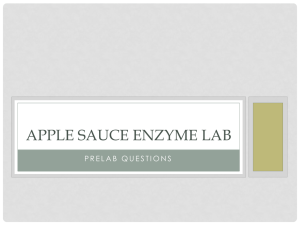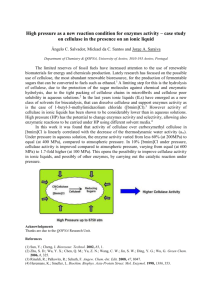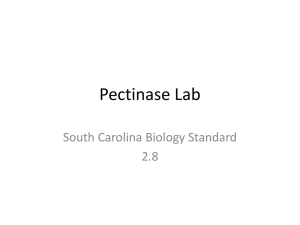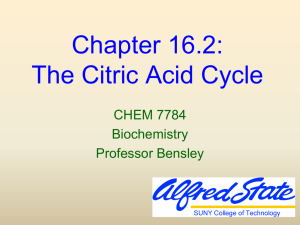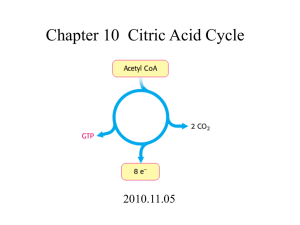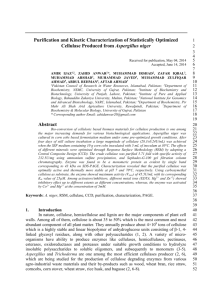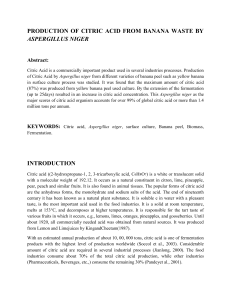Full Text - Life Science Journal
advertisement
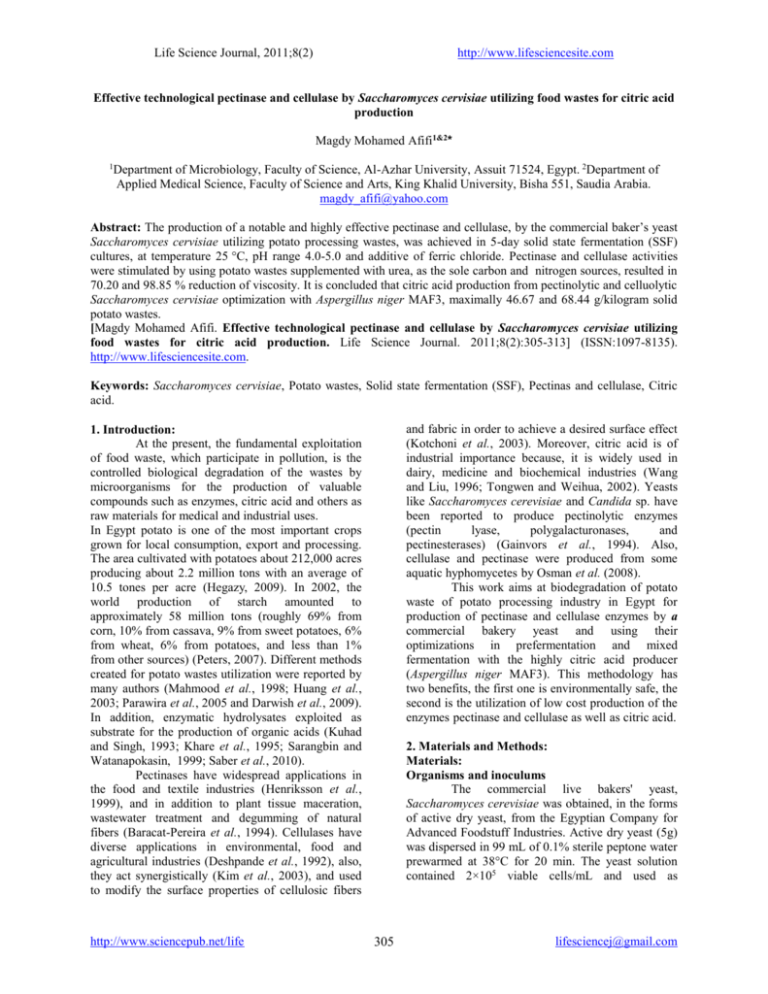
Life Science Journal, 2011;8(2) http://www.lifesciencesite.com Effective technological pectinase and cellulase by Saccharomyces cervisiae utilizing food wastes for citric acid production Magdy Mohamed Afifi1&2* 1 Department of Microbiology, Faculty of Science, Al-Azhar University, Assuit 71524, Egypt. 2Department of Applied Medical Science, Faculty of Science and Arts, King Khalid University, Bisha 551, Saudia Arabia. magdy_afifi@yahoo.com Abstract: The production of a notable and highly effective pectinase and cellulase, by the commercial baker’s yeast Saccharomyces cervisiae utilizing potato processing wastes, was achieved in 5-day solid state fermentation (SSF) cultures, at temperature 25 °C, pH range 4.0-5.0 and additive of ferric chloride. Pectinase and cellulase activities were stimulated by using potato wastes supplemented with urea, as the sole carbon and nitrogen sources, resulted in 70.20 and 98.85 % reduction of viscosity. It is concluded that citric acid production from pectinolytic and celluolytic Saccharomyces cervisiae optimization with Aspergillus niger MAF3, maximally 46.67 and 68.44 g/kilogram solid potato wastes. [Magdy Mohamed Afifi. Effective technological pectinase and cellulase by Saccharomyces cervisiae utilizing food wastes for citric acid production. Life Science Journal. 2011;8(2):305-313] (ISSN:1097-8135). http://www.lifesciencesite.com. Keywords: Saccharomyces cervisiae, Potato wastes, Solid state fermentation (SSF), Pectinas and cellulase, Citric acid. and fabric in order to achieve a desired surface effect (Kotchoni et al., 2003). Moreover, citric acid is of industrial importance because, it is widely used in dairy, medicine and biochemical industries (Wang and Liu, 1996; Tongwen and Weihua, 2002). Yeasts like Saccharomyces cerevisiae and Candida sp. have been reported to produce pectinolytic enzymes (pectin lyase, polygalacturonases, and pectinesterases) (Gainvors et al., 1994). Also, cellulase and pectinase were produced from some aquatic hyphomycetes by Osman et al. (2008). This work aims at biodegradation of potato waste of potato processing industry in Egypt for production of pectinase and cellulase enzymes by a commercial bakery yeast and using their optimizations in prefermentation and mixed fermentation with the highly citric acid producer (Aspergillus niger MAF3). This methodology has two benefits, the first one is environmentally safe, the second is the utilization of low cost production of the enzymes pectinase and cellulase as well as citric acid. 1. Introduction: At the present, the fundamental exploitation of food waste, which participate in pollution, is the controlled biological degradation of the wastes by microorganisms for the production of valuable compounds such as enzymes, citric acid and others as raw materials for medical and industrial uses. In Egypt potato is one of the most important crops grown for local consumption, export and processing. The area cultivated with potatoes about 212,000 acres producing about 2.2 million tons with an average of 10.5 tones per acre (Hegazy, 2009). In 2002, the world production of starch amounted to approximately 58 million tons (roughly 69% from corn, 10% from cassava, 9% from sweet potatoes, 6% from wheat, 6% from potatoes, and less than 1% from other sources) (Peters, 2007). Different methods created for potato wastes utilization were reported by many authors (Mahmood et al., 1998; Huang et al., 2003; Parawira et al., 2005 and Darwish et al., 2009). In addition, enzymatic hydrolysates exploited as substrate for the production of organic acids (Kuhad and Singh, 1993; Khare et al., 1995; Sarangbin and Watanapokasin, 1999; Saber et al., 2010). Pectinases have widespread applications in the food and textile industries (Henriksson et al., 1999), and in addition to plant tissue maceration, wastewater treatment and degumming of natural fibers (Baracat-Pereira et al., 1994). Cellulases have diverse applications in environmental, food and agricultural industries (Deshpande et al., 1992), also, they act synergistically (Kim et al., 2003), and used to modify the surface properties of cellulosic fibers http://www.sciencepub.net/life 2. Materials and Methods: Materials: Organisms and inoculums The commercial live bakers' yeast, Saccharomyces cerevisiae was obtained, in the forms of active dry yeast, from the Egyptian Company for Advanced Foodstuff Industries. Active dry yeast (5g) was dispersed in 99 mL of 0.1% sterile peptone water prewarmed at 38°C for 20 min. The yeast solution contained 2×105 viable cells/mL and used as 305 lifesciencej@gmail.com Life Science Journal, 2011;8(2) http://www.lifesciencesite.com inoculum for fermentation medium (Wang et al., 1997). The fungal species A. niger MAF3 was obtained from Botany and Microbiology Department, Faculty of Science, Al-Azhar University, Assiut, Egypt. A. niger MAF3 spores were produced in Czapek-Dox Broth (50 ml) in a 250 ml Erlenmeyer flask, incubated at 28°C for eight days. A spore suspension was prepared by adding 25 ml distilled water with Tween-80 (0.1%) and was stored at 4°C for a maximum of two weeks. It contained 107 spores/ml according to the method described by Vandenberghe et al. (2000). Fermentation medium Solid potato wastes were obtained from potato processing industry (chips), Assiut, Egypt. The other components of the SSF culture media were obtained from Merck and Sigma in the highest purity. Ten grams of solid potato wastes were taken in Erlenmeyer flask (250 ml), mixed with 10 ml of Czapek-Dox mineral solution, and sterilized at 121 °C for 30 min. Cultivation was carried out by adding 1.0 ml of the inoculum then the flasks were incubated at 30°C statically. Preparation of crude enzyme extract Culture media and cells were harvested after incubation for 7 days by filling to 100 ml of sterilized distilled water. The mixture was vigorously stirred for about 15 min and filtered through Whatman No. 1 filter paper on Büchner funnel, and centrifuged at 5000 rpm and 4 °C for 15 min. The supernatant thus obtained was used as crude enzyme preparation. the organisms simultaneously at the start (PF-3). Other fermentation conditions were kept as described above in Section 2.2, unless, the supernatant fluid thus obtained was used for citric acid estimation. Analysis for citric acid The concentration of citric acid in culture filtrate was measured by titration with 0.1 N NaOH as described by (Imandi et al. 2007; Khosravi-Darani and Zoghi, 2008). After titration, citric acid was determined spectrophotometrically at 420 nm by the acetic anhydride-pyridine method according to (Marrier and Boulet, 1958; Imandi et al., 2008). 3. Results and Discussion Several created methods for utilizing potato wastes in order to support the growth and extracellular hydrolytic enzyme production have been described (Mahmood et al., 1998; Parawira et al., 2005; Darwish et al., 2009). In addition, (Kuhad and Singh, 1993; Khare et al. 1995; Sarangbin and Watanapokasin, 1999; Saber et al., 2010) pointed out that the enzymatic hydrolysates exploited as substrate for the production of organic acids which strongly pronounced them for multienzyme complexes' production through microbial biodegradation. This therefore justified this study for the perfect utilization of SPW, excluded in the potato processing factories in Egypt (chips), as a substrate material suitable for a commercial baker's yeast strain capable of the production of pectinase and cellulase enzymes, as well as utilization of their hydrolysates for production of citric acid, essential for numerous applications. When the commercial bakers yeast (Saccharomyces cerevisiae) was grown on SPW as a solid support in SSF, could produce pectinase and cellulase as high as 17.45 and 49.20 % reduction of viscosity after 5 days incubation (Fig. 1). Similarly, Aspergillus carneus NRC1 produced the highest yield of pectinase, cellulase and high hemicellulase after 5 days (El-Sheekh et al., 2009). Also, the optimum production of pectic enzymes by Trichoderma lignorum attained after 5-day (Abdel-Fattah et al., 1977). In addition, the maximum filter paperase (FPase) activity was 19.5 IU g−1 in 4 days, while, the highest CMCase activity was concurrently obtained after 5-6 days of fermentation when A. niger KK2 was grown on rice straw alone as a solid support in SSF (Kang et al., 2004). In relation to these results, the cellulose (CEL) culture were statistically similar to those from the 3rd and 4th days of the untreated sugar cane bagasse (SCB) using Penicillium echinulatum 9A02S1 culture, and the 5th and 6th days gave the greatest filter paper activity (FPA) (Camassola and Dillon, 2009). On contrast, the maximum cellulase secretion from A. niger using maize straw was after 3 Methods: Assay for pectinase activity Pectinase activity was measured as reduction percentage in pectin solution viscosity using Ostwald viscometer according to White and Fabian (1953). Assay for CM-cellulase activity. CM-cellulase was measured viscometrically as described by (Eriksson and Hollmark, 1969; Child et al., 1973, El-Sheekh et al., 2009). Pre-fermentation and mixed fermentation This experiment was performed as the method of Khare et al. (1995). In this set of experiments, SPW was pre-fermented with the optimization of SSF of pectinolytic and celluolytic Saccharomyces cervisiae, prior to inoculation with the citric acid- producing A. niger MAF3. In one set pre-fermented SPW samples were sterilized after the fifth day to kill the pre-fermenting Saccharomyces cervisiae and then inoculated with A. niger MAF3 (PF-1). In a second set, A. niger MAF3 was inoculated on the fifth day without killing Saccharomyces cervisiae (PF-2), and the third set was a mixed fermentation created by inoculating both http://www.sciencepub.net/life 306 lifesciencej@gmail.com Life Science Journal, 2011;8(2) http://www.lifesciencesite.com days of incubation (Milala et al., 2005), moreover, the maximum of FPase, carboxy methyl cellulase (CMCase) and xylanase activity was obtained after 7 days incubation of Aspergillus oryzae MTCC 1846 at 28 ± 0.5) (Chandel et al., 2009). The addition of different mono- and disaccharides in equal carbon basis in the production medium led to low or high enzyme activities. The control culture characterized by the highest levels of enzymes activity (58.50 and 65.0 % reduction of viscosity) for pectinase and cellulase, respectively. This distinctly reflects the effect of inducible substrate type of the enzymes involved by the commercial bakery yeast (Fig. 2). The inducible nature of the aforementioned fungal enzymes was previously reported (Ismail, 1996; Silva et al., 2002; Bai et al., 2004). In addition, the control culture using Penicillium echinulatum 9A02S1, gave the greatest FPA (Camassola and Dillon , 2009), while, the cellulase production from A. niger NRRL 2001 and A. niger NRRL 2007 reporting 5 and 6 U/ml of cellulase, consequently, using de-starched corn fiber as a carbon source (Dien et al., 2006). The initial pH of the basal medium ranged from 3.0 to 11.0 (Fig. 3) and that was suitable for pectinase and cellualase enzymes produced by Saccharomyces cervisiae. The marked effect of initial pH 4 and 5 was mainly on pectinase and cellulase enzyme productivities which reached their maximal value of 52.12 and 69.50 % reduction of viscosity, consequently. An increase in initial pH of fermentation above 4 and 5 shows a decrease in pectinase and cellulase enzymes productivity, consequently. Similarly, Foda et al. (1984) reported the optimum initial pH values for polygalacturonase (PG) enzyme production were 4.0–5.0 for A. aculeatus. Birgisson et al. (2003) concluded the production of PG by Cystofilobasidium larimarini (55,000 U/l) and C. capitatum (32,000 U/l) was maximum at an optimum pH of 3.2 and 3.9, respectively. CMCase showed optimal activity at pH 5.0, while xylanase, pectinase and FPase activities were optimal at pH 6.0 as reported by Parawira et al. (2005). In contrast to these results, Gummadi and Kumar (2008) reported the optimum pH for pectin lyase (PL) and pectate lyase (PGL) production by Debaryomyces nepalensis was found to be 7.0. From one hand, while PL production was achieved at an initial pH 6.5 on the other (Manachini et al., 1988). In addition, the optimum pH for pectin lyase activity was 8.0 (Solís et al., 2009). Hence, in all subsequent experiments, initial pH of the medium was http://www.sciencepub.net/life maintained at 4 and 5 for pectinase and cellulase enzyme productivities. Pectinase and cellulase production was investigated in a temperature range of 15–60 °C. The highest production of pectinase and cellulase activities (66.0 and 98. 85 % Reduction of viscosity), respectively, were obtained at 25 °C and at higher temperatures their production decreased gradually (Fig. 3). The incubation temperature in previous range is favored and denoting good mesophilicity of pectinase and cellulase and their producer Saccharomyces cervisiae. This adds good applicable advantage to the crude Saccharomyces cervisiae pectinase and cellulase. Thus, Saccharomyces cervisiae was, a little similar to, Aspergillus foetidus (NRRL 341, ATCC 16878) which optimally produced pectinases at 30 °C (Hours et al., 1988), and A. niger A-20 was optimally produced multienzyme systems of pectinases, cellulases and xylanase at 30 °C (Ismail, 1996) from one hand, and differ to, A. carneus NRC1 which favored pectinases production at 50 °C (El-Sheekh et al., 2009). In respect to enzyme activity, the simultaneous addition of glucoamylase and yeast (Saccharomyces cerevisiae) was performed at 30 °C (Srichuwong et al. (2009), while, and the optimal activities was at 50 and 60 °C for pectinase and CMCase, respectively (Parawira et al., 2005). Study of the effect of the SPW quantity in the SSF culture medium using pectinas and cellulase enzymes, indicated that their productivities increased parallely with the added SPW till 25 and 80g which represented the most proper concentrations for obtaining the highest productivities (69.3 and 96 % reduction of viscosity), respectively (Fig. 5). Break down of cell-wall materials causing by the hydrolytic activities of enzymes was clearly observed. According to the results of these studies, orange bagasse 50% (w/w) and wheat bran mixture was the most proper for the maximal pectin lyase productivity in SSF cultures of Penicillium viridicatum Rfe3 (Silva et al., 2002). Taking the pectin content of orange peels and pulps (OPP) into consideration, the proper percentage 6% (w/v) equals 1.44% (w/v) pectin (El-Sheekh et al., 2009) and also this was near to that concluded for apple pectin by Abdel-Fattah et al. (1977) for optimum production of pectic enzymes by Trichoderma lignorum. Moreover, the maximum cellulase secretion from A. niger obtained using 6% maize straw concentration (Milala et al., 2005). 307 lifesciencej@gmail.com Life Science Journal, 2011;8(2) http://www.lifesciencesite.com Enzyme (pectinase & cellulase) activities (% Reduction in viscosity) Table 1. Effect of pre-fermentation and mixed fermentation in the optimized medium pectinase and cellulase enzymes productivity by Saccharomyces cervisiae cultures for citric acid production. Optimized pectinase medium Optimized cellulase medium Treatment Citric acid (g/kg SPW) Final pH Citric acid (g/kg SPW) Final pH OM 15.86 2.98 2.47 5.11 PF-1 17.61 2.34 14.69 2.33 PF-2 6.17 6.52 4.61 4.53 PF-3 46.67 2.02 68.44 2.05 OM Optimized medium of each enzyme produced by Saccharomyces cervisiae. PF-1 Prefermented with Saccharomyces cervisiae for 5 days and sterilized followed by A. niger MAF3. PF-2 Prefermented with Saccharomyces cervisiae for 5 days followed by inoculation with A. niger MAF3. PF-3 Mixed fermentation with both fungi inoculated at 0 day. Citric acid measured at 5 days after inoculation of A. niger MAF3. pectinase cellulase 50 40 30 20 10 0 2 3 4 5 6 7 8 Period of incubation (days) Fig. 1. The pectinase and cellulase enzymes activities (% reduction in viscosity) of the SSF culture filtrates of static Saccharomyces cerevisiae cultures during different periods of incubation Enzyme (pectinase & cellulase) activities (% Reduction in viscosity) 70 Pectinase Cellulase 60 50 40 30 20 10 0 Fructose Maltose Lactose Sucrose Glucose Control Carbon Source Fig. 2. Effect of different carbon sources on pectinase and cellulase enzymes productivity by Saccharomyces cervisiae in 5-day static cultures. http://www.sciencepub.net/life 308 lifesciencej@gmail.com Enzyme (pectinase & cellulase) activities (% Reduction in viscosity Life Science Journal, 2011;8(2) http://www.lifesciencesite.com 80 Pectinase Cellulase 70 60 50 40 30 20 10 0 2 4 6 8 10 12 pH value Enzyme (pectinase & cellulase) activities (% Reduction in viscosity) Fig. 3. Influence of initial pH value on pectinase and cellulase enzymes productivities by S. cerevisiae grown for 5 days in static cultures. Pectinase Cellulase 100 90 80 70 60 50 40 30 20 10 0 10 20 30 40 50 60 Incubation temperature (°C) Fig. 4. Effect of incubation temperatures on pectinase and cellulase productivities by Saccharomyces cervisiae in 5-day SSF cultures. http://www.sciencepub.net/life 309 lifesciencej@gmail.com Enzyme (pectinase & cellulase) activities (% Reduction in viscosity) Life Science Journal, 2011;8(2) http://www.lifesciencesite.com Pectinase Cellulase 100 90 80 70 60 50 40 30 20 10 0 0 20 40 60 80 100 Substrate concentration (g) Fig. 5. Effect of solid potato waste (SPW) quantity in SSF cultures on pectinase and cellulase productivity by Saccharomyces cervisiae in 5-day static cultures. Enzyme (pectinase & cellulase) activities (% Reduction in viscosity) 100 Pectinase Cellulase 90 80 70 60 50 40 30 20 10 0 ne Urea phate lphate asine elatine lysine ontrol) C G te (c Pepto G phos m su ra niummmoniu m nit o m A Am Sodiu Enzyme (pectinase & cellulase) activities (% Reduction in viscosity) Fig. 6. Effect of different Nitrogen sources on pectinase and cellulase enzymes productivities by Saccharomyces cervisiae grown for 5 days in static SSF cultures. 100 Pectinase Cellulase 90 80 70 60 50 40 30 20 10 0 Glyc erol annitol Sorbitol Starch Pectinellulose FeCl3 ZnSO4+ FeCl3 Control M 4 C ZnSO Additives Fig. 7. Effect of different additives (1% w/w) to the optimizes medium pectinase and cellulase enzymes productivity by Saccharomyces cervisiaegrown in 5- day static SSF cultures. http://www.sciencepub.net/life 310 lifesciencej@gmail.com Life Science Journal, 2011;8(2) http://www.lifesciencesite.com The effect of different nitrogen sources was investigated by replacement of NaNO3 in equal nitrogen basis by any of N sources (peptone, urea, ammonium phosphate, ammonium sulphate, casein, gelatin or glysine) to verify their suitability for pectinase and cellulase enzymes production by S. cerevisiae. As shown in Fig. 6, the replacement of NaNO3 in the SSF culture medium by any of the above-mentioned N sources led to many dissimilar effects on the productivity of the pectinase and cellulase enzymes. Generally, some N sources tested led to moderate or good pectinase (except peptone, gelatin and glysine show a low effect) and cellulase productivities, particularly urea by which the highest pectinase and cellulase yield was attained, and resulted in 70.20 and 98.85 (% reduction of viscosity), consequently.Yeast cells require sufficient nutrients to survive the osmotic stress and maintain their metabolic functions. Nitrogen limitation for protein synthesis and yeast growth is particularly observed in very high gravity (VHG) fermentation, which can be remedied by the addition of assimilable nitrogen sources such as yeast extract, urea and ammonium salts (D'Amore et al., 1988; Jones and Ingledew, 1994;; Blateyron and Sablayrolles, 2001). The effect of some additives on pectinase and cellulase enzymes productivities by Saccharomyces cervisiaewas was graphically illustrated in Fig.7. These additives included, some polyalcohols (glycerol, mannitol and sorbitol), polysaccharides (starch, pectin and cellulose), and metal ions (FeCl3, ZnSO4, and FeCl3 + ZnSO4 0.5+0.5% w/w) and added in equal weight basis (1%, w/w). Among all the additives above-mentioned FeCl3, highly stimulated cellulase and moderately stimulated pectiase, productivity (95 and 60% reduction of viscosity), respectively, while, the others had varied stimulatory effects. Each of glycerol, manitol and Zn2+ had completed inhibitory effects. Fungal pectinases production media formulated by many authors and principally contained orange bagasse or peels were devoid of the metal ions Zn2+ and Fe3+ (Ismail, 1996; Silva et al., 2002). Study of the effects of the prefermentation and mixed ermentation pointed out that a maximum of a manyfolds increase in citric acid yield was obtained in the case of mixed fermentation with both Saccharomyces cervisiae and A. niger MAF3 inoculated at 0 day (PF3), and resulted in the production of 46.67 and 68.44 g citric acid/kilogram potato waste, consequently, which is quite, similar to the condition recorded by Khare et al., 1995, and comparable to the yields obtained by fermentation of other agro-wastes (Panda et al., 1984; E1-Abayad et al., 1992; Khare et al., 1995; Pramod and Lingappa, 2008). 5. Conclusion: In conclusion, using a pectinolytic and celluolytic Saccaromyces cerevisiae utilizing solid potato wastes, as sole carbon source at a concentration of 15 and 85g at pH 4 and 5, supplemented with urea and FeCl3, and incubated at 25 °C for 5 days, represented the optimal conditions to attain the highest pectinase and cellulase yield (70.2 and 98. 85 % reduction of viscosity), consequently. These conditions were, used in pre and mixed fermentation with the highly citric acid producer A. niger MAF3, maximally produced 46.67 and 68.44 g citric acid/kilogram solid potato waste in pectinase and cellulase mediaum optimization, respectively. This offers an opportunity to recover potato chips by-products and used as substrate for producing the cheapest with the highest productivities of cellulase and pectinase, as well as citric acid to be used in food and biochemical industries. http://www.sciencepub.net/life References: 1. Abdel-Fattah AF, Mabrouk SS, Ismail AS (1977). Production of polygalacturonase and pectinmethylesterase by fungi. Chemie Mikrobiologie Technologie der Lebensmittel, 5: 38–41. 3. Bai ZH, Zhang HX, Qi HY, Peng XW, Li BJ (2004). Pectinase production by Aspergillus niger using wastewater in solid state fermentation for eliciting plant disease resistance. Bioresource Technology, 95: 49–52. 4. Baracat-Pereira MC, Coelho JLC, Silva DO, (1994). Production of pectin lyase by Penicillium griseoroseum cultured on sucrose and yeast extract for degumming of natural fibers. Letters Applied Microbiology, 18: 127–129. 5. Birgisson H, Delgado O, Garcia AL, Hatti-Kaul R, Mattiasson B (2003). Cold-adapted yeasts as producers of cold-active polygalacturonases. Extremophiles, 7: 185–193. 6. Blateyron L, Sablayrolles JM (2001). Stuck and slow fermentations in ecology: statistical study of causes and effectiveness of combined additions of oxygen and diammonium phosphate. J Biosci Bioeng., 91: 184–189. 7. Camassola M, Dillon AJP (2009). Biological pretreatment of sugar cane bagasse for the production of cellulases and xylanases by Penicillium echinulatum. Industrial Crops and Products, 29, 2-3: 642-647. 8. Chandel AK, Narasu ML, Chandrasekhar G, Manikyam A, Rao, LV (2009). Use of Saccharum spontaneum (wild sugarcane) as biomaterial for cell immobilization and modulated ethanol production by thermotolerant Saccharomyces cerevisiae VS3. Bioresource Technology, 100, 8: 2404-2410. 311 lifesciencej@gmail.com Life Science Journal, 2011;8(2) 9. 10. 11. 12. 13. 14. 15. 16. 17. 18. 19. 20. 21. http://www.lifesciencesite.com Child JJ, Eveleigh DE, Sieben AS (1973). Determination of cellulose activity using hydroxyethylcellulose as substrate. Canadian Journal of Biochemistry, 51: 39–43. D'Amore T, Panchal JC, Russell I, Stewart GG (1988). Osmotic pressure effects and intracellular accumulation of ethanol in yeast during fermentation. J Ind Microbiol, 2: 365–372. Darwish SMI, Afifi, MM, Mostafa, EM, ElShanawany, A A (2009). Production of amylase enzymes by filamentous fungi, Assuit Univ. J. of Botany, 38, 2: 1-14. Deshpande MS, Rale VB, Lynch JM (1992). Aureobasidium pullulans in applied microbiology: a status report. Enzyme Microb Technol., 14: 514–527. Dien BS, Li XL, Iten LB, Jordan, DB, Nichols NN, O’Brayan, PJ, Cotta MA (2006). Enzymatic saccharification of hot-water pretreated corn fiber for production of monosaccharide. Enzyme microb. Technol., 39: 1137-1144. El-Abayad MS, Hamissa, FA, Gad, AS (1992). Treatment of beet molasses for citric acid production by a potent strain of Aspergillus niger van Tieghem. Biores.Technol., 39: 191-197. El-Sheekh MM, Ismail AS, El-Abd MA, Hegazy EM, El-Diwany AI (2009). Effective technological pectinases by Aspergillus carneus NRC1 utilizing the Egyptian orange juice industry scraps. International Biodeterioration & Biodegradation, 63, 1:12-18. Eriksson KE, Hollmark BH (1969). Kinetic studies of the action of cellulose on sodium carboxymethylcellulose. Archives of Biochemistry & Biophysics, 133: 233–237. Foda MS, Hussein MF, Gibriel AY, Rizk LRS, Basha SI (1984). Physiology of polygalacturonases formation by Aspergillus aculeatus and Mucor pusillus. Egypt J. Microbiol., 19: 181–185. Gainvors A, Frezier V, Lemaresquier H, Lequart C, Aigle M, Belarbi A (1994). Detection of polygalacturonase, pectin-lyase, and pectinesterase activities in a Saccharomyces cerevisiae strain. Yeast, 11: 1493–1499. Gummadi SN, Kumar, DS (2008). Batch and fed batch production of pectin lyase and pectate lyase by novel strain Debaryomyces nepalensis in bioreactor. Bioresource Technology, 99, 4: 874881. Hegazy ES (2009). Seed potato production in Egypt. Agrofood Co. Cairo, Egypt. www.unece. org/trad/agr/meetings/ge…/Egypt…/s4_SalahHe gazy.pdf. Henriksson GA, Slomczynski D, Eriksson KEL (1999). Production of highly efficient enzymes http://www.sciencepub.net/life 22. 23. 24. 25. 26. 27. 28. 29. for flax retting by Rhizomucor pusillus. Journal of Biotechnology, 68: 115–123. Hours RA, Voget CE, Ertola RJ (1988). Some factors affecting pectinase production from apple pomace in solid-state cultures. Biological Wastes, 24: 147–157. Huang LP, Jin B, Lant P, Zhou J (2003). Biotechnological production of lactic acid integrated with potato wastewater treatment by Rhizopus arrhizus. J Chem Technol Biotechnol., 78: 899–906. Imandi SB, Bandaru VVR, Somalanka SR, Bandaru SR, Garapati HR (2008). Application of statistical experimental designs for the optimization of medium constituents for the production of citric acid from pineapple waste. Bioresource Technology, 99, 10: 4445-4450. Imandi SB, Bandaru VVR, Somalanka SR, Garapati HR (2007). Optimization of medium constituents for the production of citric acid from byproduct glycerol using doehlert experimental design. Enzyme Microbial. Technol., 40: 1367– 1372. Ismail AS (1996). Utilization of orange peels for the production of multienzyme complexes by some fungal strains. Process Biochemistry, 31: 645–650. Jones AM, Ingledew WM (1994). Fuel alcohol production: appraisal of nitrogenous yeast foods for very high gravity wheat mash fermentation. Process Biochem., 29: 483–488. Kang SW, Park YS, Lee JS, Hong SI, Kim SW (2004). Production of cellulases and hemicellulases by Aspergillus niger KK2 from lignocellulosic biomass. Bioresource Technology, 91, 2: 153-156. Khare SK, Jha K, Gandhi AP (1995). Citric acidproduction from Okara (soy-residue) by solidstate fermentation. Bioresource Technology, 54: 323-325. 30. Khosravi-Darani K, Zoghi A (2008). Comparison of pretreatment strategies of sugarcane baggase: Experimental design for citric acid production. Bioresource Technology, 99, 15: 6986-6993. 31. Kim KC, Yoo SS, Oh YA, Kim SJ (2003). Isolation and characteristics of Trichoderma harzianum FJ1 producing cellulases and xylanase. J Microb Biotechnol., 13: 1–8. 32. Kotchoni OS, Shonukan OO, Gachomo WE (2003). Bacillus pumillus, BPCR16, a promising candidate for cellulase production under conditions of catabolic repression. Afr. J. Biotechnol., 2: 140-146.Kuhad RC, Singh A (1993). Lignocellulose biotechnology: current and 312 lifesciencej@gmail.com Life Science Journal, 2011;8(2) 34. 35. 36. 37. 38. 39. 40. 41. 42. 43. http://www.lifesciencesite.com future prospects. Crit. Rev. Biotechnol., 13: 151– 172. Mahmood AU, Greenman J, Scragg AH (1998). Orange and potato peel extracts: Analysis and use as Bacillus substrates for the production of extracellular enzymes in continuous culture. Enzyme and Microbial Technology, 22, 2: 130137. Manachini PL, Parini C, Fortina MG (1988). Pectic enzymes from Aureobasidium pullalans LV 10. Enzyme Microb. Technol., 10: 682–685. Marrier JR, Boulet M (1958). Direct determination of citric acid in milk with an improved pyridine acetic anhydride method. J. Dairy Sci., 41: 1683-1692. Milala MA, Shugaba A, Gidado A, Ene AC, Wafar JA (2005). Studies on the use of agricultural wastes for cellulase enzyme production by A. niger. Res. J. Agr. Biol. Sci., 1, 4: 325-328. Osman ME, Om-Kalthoum HK, El-Shaphy AA (2008). Production of cellulase and pectinase from some aquatic hyphomycetes. Res. J. Microbiol., 3: 213-224. Panda T, Kundu S, Majumdar SK (1984). Studies on citric acid production by Aspergillus niger using treated cane molasses. Proc. Biochem., 19: 183-187. Parawira W, Murto M, Read JS, Mattiasson B (2005). Profile of hydrolases and biogas production during two-stage mesophilic anaerobic digestion of solid potato waste. Process Biochemistry, 40, 9: 2945-2952. Peters D (2007). Raw materials. Adv. Biochem. Eng. Biotechnol. 105: 1–30. Pramod T, Lingappa K (2008). Immobilization of Aspergillus niger in polyurethane foam for citric acid production from carob pod extract. Am. J. Food Technol., 3: 252-256. Saber, WIA, El-Ahmady, El-Naggar N, AbdAlAziz SA (2010). Bioconversion of lignocellulosic wastes into organic acids by cellulolytic rock phosphate-solubilizing fungal isolates grown under solid-state fermentation conditions. Res. J. Microbiol., 5: 1-20. 44. Sarangbin MS, Watanapokasin Y (1999). Yam bean starch: a novel substrate for citric acid production by the protease-negative mutant strain of Aspergillus niger. Carbohydrate Polymers, 219-224 45. Silva D, Martins ES, Silva R, Gomes E (2002). Pectinase production by Penicillium viridicatum RFC3 by solid state fermentation using agricultural wastes and agro-industrial byproducts. Brazilian Journal of Microbiology, 33: 318–324. 46. Solís S, Loeza J, Segura G, Tello J, Reyes N, Lappe P Guitérrez L, Ríos F, Huitrón C (2009). Hydrolysis of orange peel by a pectin lyaseoverproducing hybrid obtained by protoplast fusion between mutant pectinolytic Aspergillus flavipes and Aspergillus niveus CH-Y-1043. Enzyme and Microbial Technology, 5: 123-128. 47. Srichuwong S, Fujiwara M, Wang X, Seyama T, Shiroma R, Arakane M, Mukojima N, Tokuyasu K (2009). Simultaneous saccharification and fermentation (SSF) of very high gravity (VHG) potato mash for the production of ethanol. Biomass and Bioenergy,33, 5: 890-898. 48. Tongwen XU, Weihua Y (2002). Citric acid production by electrodialysis with bipolar membranes. Chem. Eng. Process, 41: 519–524. 49. Vandenberghe LPS, Soccol CR, Pandey A, Lebeault JM (2000). Solid-state fermentation for the synthesis of citric acid by Aspergillus niger. Bioresource Technology, 74 : 175-178 50. Wang J, Liu P (1996). Comparison of citric acid production by Aspergillus niger immobilized in gels and cryogels of polyacryl-amide. J. Ind. Microbiol., 16: 351–353. 51. Wang S, Thomas KC, Ingledew W M, Sosulski K, Sosulski FW (1997). Rye and triticale as feedstock for fuel ethanol production. Cereal Chem., 74, 5: 621–625. 52. White LS and Fabian, FW (1953). The pectolytic activity of molds isolated from black raspberries. Applied Microbiology, 1: 243–247. 3/3/2011 http://www.sciencepub.net/life 313 lifesciencej@gmail.com
